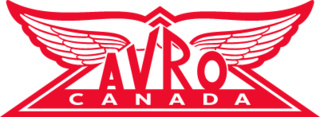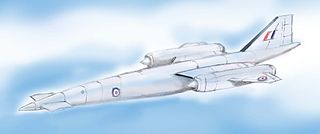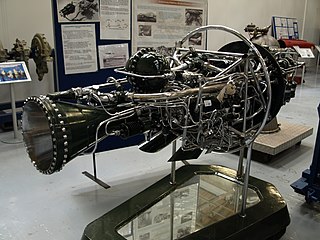
The Avro Blue Steel was a British air-launched, rocket-propelled nuclear armed standoff missile, built to arm the V bomber force. It allowed the bomber to launch the missile against its target while still outside the range of surface-to-air missiles (SAMs). The missile proceeded to the target at speeds up to Mach 3, and would trigger within 100 m of the pre-defined target point.

Avro was a British aircraft manufacturer. Its designs include the Avro 504, used as a trainer in the First World War, the Avro Lancaster, one of the pre-eminent bombers of the Second World War, and the delta wing Avro Vulcan, a stalwart of the Cold War.

Avro Canada was a Canadian aircraft manufacturing company. It started in 1945 as an aircraft plant and within thirteen years became the third-largest company in Canada, one of the largest 100 companies in the world, and directly employing over 50,000. Avro Canada was best known for the CF-105 Arrow, but through growth and acquisition, it rapidly became a major, integrated company that had diverse holdings.

The Republic XF-91 Thunderceptor is a mixed-propulsion prototype interceptor aircraft, developed by Republic Aviation. The aircraft would use a jet engine for most flight, and a cluster of four small rocket engines for added thrust during climb and interception. The design was largely obsolete by the time it was completed due to the rapidly increasing performance of contemporary jet engines, and only two prototypes were built. One of these was the first American fighter to exceed Mach 1 in level flight.

The Saunders-Roe SR.45 Princess was a British flying boat aircraft developed and built by Saunders-Roe at their Cowes facility on the Isle of Wight. It has the distinction of being the largest all-metal flying boat to have ever been constructed.
Saunders-Roe Limited, also known as Saro, was a British aero- and marine-engineering company based at Columbine Works, East Cowes, Isle of Wight.

The Saunders-Roe SR.53 was a British prototype interceptor aircraft of mixed jet and rocket propulsion developed for the Royal Air Force (RAF) by Saunders-Roe in the early 1950s. As envisaged, the SR.53 would have been used as an interceptor aircraft, using its rocket propulsion to rapidly climb and approach incoming hostile bombers at high speeds; following its attack run, the aircraft would be able to return to its base by making use of the secondary jet propulsion instead.

The Saunders-Roe SR.177 was a 1950s project to develop a combined jet- and rocket-powered interceptor aircraft for the Royal Air Force (RAF) and Royal Navy. It was an enlarged derivative of the Saunders-Roe SR.53, which was itself an experimental combined jet-and-rocket interceptor aircraft.

A rocket-powered aircraft or rocket plane is an aircraft that uses a rocket engine for propulsion, sometimes in addition to airbreathing jet engines. Rocket planes can achieve much higher speeds than similarly sized jet aircraft, but typically for at most a few minutes of powered operation, followed by a gliding flight. Unhindered by the need for oxygen from the atmosphere, they are suitable for very high-altitude flight. They are also capable of delivering much higher acceleration and shorter takeoffs. Many rocket aircraft may be drop launched from transport planes, as take-off from ground may leave them with insufficient time to reach high altitudes.
The Hawker P.1072 was a 1949 experimental British aircraft acting as a test bed for the Armstrong Siddeley Snarler rocket booster engine. It was the prototype Hawker Sea Hawk modified to install the rocket in the tail.

The de Havilland Spectre was a rocket engine built by the de Havilland Engine Company in the 1950s. It was one element of the intended mixed power-plant for combination rocket-jet interceptor aircraft of the Royal Air Force, such as the Saunders-Roe SR.177.

The Avro 730 was a planned Mach 3 reconnaissance aircraft and strategic bomber that was being developed by Avro Aircraft for the Royal Air Force (RAF). It had been originally envisioned as a very high-speed aircraft to perform aerial reconnaissance missions, conforming with the requirements of Air Ministry Specification OR.330. Avro subsequently decided to modify the design of the proposed 730 in order to accommodate its arming with nuclear weapons; this change therefore meant that the type would be able to perform the nuclear weapons delivery mission as well, which had been called for under Air Ministry Specification RB.156T which sought a high speed reconnaissance-bomber aircraft.

Operational Requirement F.155 was a specification issued by the British Ministry of Supply on 15 January 1955 for an interceptor aircraft to defend the United Kingdom from Soviet high-flying nuclear-armed supersonic bombers.

The Avro 701 Athena is a British advanced trainer aircraft built by Avro in the late 1940s. It was designed to replace the North American Harvard in the Royal Air Force, but was bought only in small numbers, the competing Boulton Paul Balliol being preferred.
The Armstrong Siddeley Snarler was a small rocket engine used for mixed-power experiments with an early turbojet engine. and was the first British liquid-fuelled rocket engine to fly.

The Armstrong Siddeley Screamer was a British rocket engine intended to power the Avro 720 manned interceptor aircraft. Thrust was variable, up to a maximum of 8,000 lbf (36 kN).

The Hawker P.1121 was a British supersonic fighter aircraft designed, but never fully completed, by Hawker Siddeley during the mid-1950s. It was designed by a team headed by Sir Sydney Camm.

The SNCASO SO.9000 Trident was a French mixed-power interceptor aircraft built by aircraft manufacturer SNCASO during the 1950s. As part of a wider effort to re-build French military power during the late 1940s and to furnish France with advanced, new domestically produced designs, a request for a supersonic-capable point-defence interceptor aircraft to equip the French Air Force was issued to SNCASO. In response, the firm designed the mixed-propulsion Trident, powered by a single SEPR rocket engine, which was augmented by wingtip-mounted turbojet engines, and the Air Force ordered two prototypes.
Maurice Joseph Brennan BSC, MIMechE, FRAes was a British aerospace engineer. His career encompassed the design and development of flying boats before the Second World War to rocket powered fighters after. He had a significant role in Britain's first indigenous rocket project and in the development of practical hovercraft (SR.N1)

The Société d'Études pour la Propulsion par Réaction (SEPR) was a French research and manufacturing company founded in 1944 which specialised in the development of liquid-fuelled rocket engines during the 1950s, 60s, 70s and 80s.
















